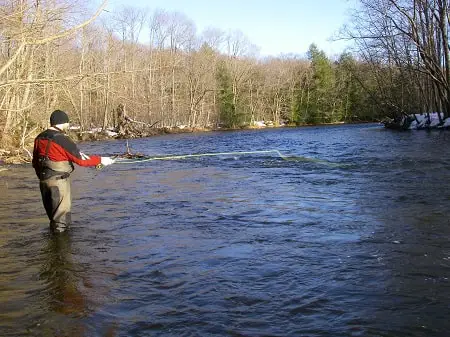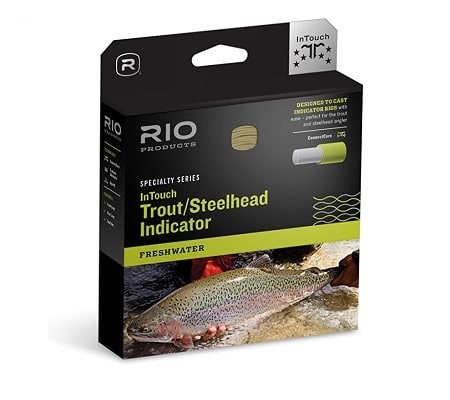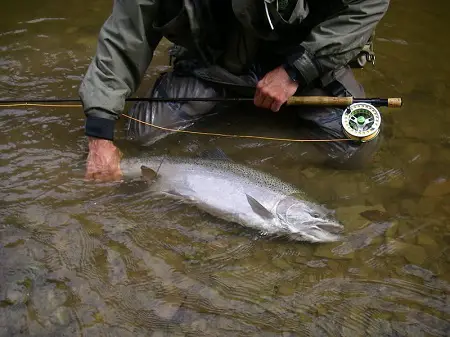How To Keep Fishing Rod Guides From Freezing: 9 Methods

Fishing in below-freezing temperatures often means ice buildup on the rod guides, and it sucks. If you don’t know how to keep fishing rod guides from freezing, it can become a big problem. I guide many days on freezing cold rivers, and I have some very cool tricks to keep my guides from freezing.
The two best ways to keep fishing rod guides from freezing are to use Stanley’s Ice Off Paste, which is designed to help keep fishing rod guides from freezing, or you can keep fishing rod guides from freezing by using the water you are fishing in, which can prevent ice build-up and can melt the ice.
When done right, both of these methods have been proven to keep fishing rod guides from freezing. Some other remedies are also available, which will be discussed below.
We may make a small commission from some of the links on this website, which is at no cost to you. I appreciate your support.
Ice in the rod guides can be a problem when casting, presenting your bait, and when fighting the fish.
Excess ice on the rod guides might even close up the rod guides completely and prevent the line from passing through them.
Each consecutive cast can mean another layer of ice. I use methods to prevent the build-up of ice and to get rid of the ice.
How To Keep Rod Guides From Freezing
There are ways to keep fishing rod guides from freezing when fishing and when fighting a fish. I have some techniques that I have shown my clients, who were amazed at how easy it is to keep the guides ice free.
Stanley’s Ice-Off Paste

Loon’s Stanley’s Ice Off Paste is one of the best ways to keep fishing rod guides from freezing and it’s the only product that is meant for this purpose. This should mean that it is tested to work and that it is also proven safe for the environment and on your rods and all your fishing lines.
For best results, it should be applied to each rod guide at home before you go fishing and left to dry. It’s kind of like a sticky, waxy paste. You can put a small amount onto a thin rag or use your finger and apply a thin layer to all the rod guides.
The paste coats the guides and prevents the water and ice from adhering to the rod guides.
Unfortunately, like all the remedies to keep fishing rod guides from freezing, Stanley’s Ice Off Paste doesn’t last all day. You may need to reapply it on the rod guides while on the river. I like it because it will often get me through the coldest part of the morning until the sun comes out and starts to warm up the rod and the air.
If you do need to re-apply, do it whenever you are going to take a break from fishing, like when you need to stop and eat or when you are going to move to another spot.

When I’m ready to stop and take a break, I will dry off each rod guide with a dry cloth or paper towel and then re-apply a thin layer of Stanley’s Ice Off Paste and then let it dry for five minutes or more.
Putting the paste onto wet guides doesn’t seem to keep rod guides from freezing very well.
Stanley’s Ice Off Paste is not the perfect solution to keep fishing rod guides from freezing, but it’s better than nothing, and it’s better than most other remedies to keep fishing rod guides from freezing.
Stanley’s Ice Off Paste will work well to keep rod guides from freezing when using mono, fluorocarbon, and fly lines.
Use Water To Keep The Ice Off The Rod Guides

One of the best tricks I give to my clients to keep fishing rod guides from freezing is to use the water you are fishing in. The water is warmer than the air and the ice on your rod guides.
On really cold days, when ice starts to form on the rod guides, I will simply dip my rod tip into the river or lake as I reel in my line.
The longer I keep the rod tip in the water, the more completely the ice melts off, and the less ice accumulation occurs in the rod guides.
When I’ve reeled my line all the way in, I lift my rod out of the water and tap the bottom of the rod blank two or three times. I tap between the handle and the first-rod guide to shake the excess water off. Three or four short, fast taps work the best.
This method works great earlier in the fall when the water is much warmer or on spring creeks or tail-water sections that don’t get as cold.
Because rivers are flowing water, the ice will come off faster than in a lake where the water isn’t moving. In the lake, I will move my rod slowly from side to side to remove the ice faster.
There are two reasons this trick works to keep fishing rod guides from freezing.
The water freezes on the rod guides as it’s exposed to the freezing air when you are reeling in the line, but if your rod is below the surface when you reel in, the rod guides and line are not exposed to the air and can’t freeze.
The water on the rod guides can still freeze after you lift the rod out of the water, so I tap the excess water off. Taping the rod can also shake off excess water from the line.
There will still be a little bit of water on the part of the line that’s on the reel, and as that line is being cast out, it could cause a little bit of ice on the rod guides. However, if you dip the rod below the surface each time you reel in, it should melt any ice off again and prevent the ice from building up.
I will only dip my rod in the water as deep as I need to clear all the rod guides that I start seeing ice on. That often means only the top 3 or 4 rod guides will get dipped in regularly because these are the rod guides that are the biggest issue.
The lower rod guides closer to the handle might only need to be dipped once every ten minutes or as soon as I see a small amount of ice.
Guide Tip: Don’t let the ice build up too much, or it will take forever for it to melt in the colder water; it’s best to dip your rod every one to three casts.
In the middle of January and February, when the water is much colder and closer to the freezing point, dipping the rod tip in the water each time you reel in is best.
This method isn’t perfect either, but I have gone all day without picking or breaking off the ice on my rod guides while other anglers are struggling with constant ice build-up.
How To Remove Ice Off The Rod Guides When It’s Thick
Be careful how you remove thick ice that has built up on your rod guides.
There will be times when it’s so cold that Stanley’s Ice Off Paste and the water trick won’t be able to keep the ice off your rod guides for long. When the ice has built up so thick that it needs to be removed, this is what I do.
Hot Breath: If the ice is so thick in and around the rod guides that it won’t break off easily by hand, I will use my hot breath to melt the ice off either completely or just enough that I can pick it off by hand. One big breath inward and then a long, slow breath released directly on the iced-up area will usually melt it enough.
Break it off with Fingers: If the ice is not too bad, I will carefully break the ice off the rod guides with my fingers. Breaking ice off with your fingers works most of the time for me, but sometimes it’s so thick in the small rod guides that it just won’t break.
You want to be careful breaking the ice off your rod guides with your hands because you might break the rod guide, pop out the ceramic insert, or even break the rod.
Use Your Teeth: If the ice is really tough to remove, I will sometimes even carefully bite the ice off or melt it with my mouth. Don’t swallow; it’s river water. I say carefully because I don’t want to damage the rod or the line with my teeth. Biting the ice off is the last resort, but I have done it before, and it works.
Once that thick ice is off, you can try to reapply Stanley’s Ice Off Paste or use the water trick again to help prevent a fast build-up of ice.
Other Methods To Keep The Ice Off The Rod Guides
I have heard of many other methods to keep the ice off the guides, but many of these use oil-based products that may cause problems with the rod or the line. It is not clear if the oils will deteriorate the lines over time, so do these at your own risk.
Some of these products may also gum up the guides and become sticky, preventing the line from flowing freely through the rod guides.
ChapStick And Lip Balm for Keeping Ice Off Rod Guides
This is a home remedy that some anglers like, but after testing this by pre-treating my rod guides before I fish, and also after I’ve cleared ice from the lines, I’ve determined that chapstick was not a great solution and did not work very well for me.
It is also uncertain if anything in the Chapstick will cause problems with the line rod components or rod finish.
Anglers I talk to tend to like the Burt’s Bees 100% Natural Moisturizing Lip Balm. You can get it at Amazon – HERE
To use this method, simply smudge some lip balm onto your fingers or a rag and apply a thin layer to each rod guide, rub off any excess or clumps with a rag.
Pam Cooking Spray To Keep Rod Guides From Freezing
This is another one of the more common home remedies that anglers have claimed works for keeping the ice off the rod guides. You simply spray it on the rod guides at home and let it dry, wipe off the excess, and go fish.
There are no studies to determine if this works at all or not or if this product is safe for your lines and rod, so use this at your own risk.
Olive Oil To Keep The Rod Guides From Freezing
Olive oil and other cooking oils are used to keep the rod guides from freezing.
Anglers apply a small amount using a Q-tip, paper towel, or rag. Like many other home remedies, some anglers say this works temporarily to slow the build-up of ice, but they may need to reapply often.
I tried this, and it did not work as well as some anglers claim. The oil may cause problems with the lines and rod guides, so use it at your own risk.
Vaseline To Keep Fishing Rod Guides From Freezing
Some anglers will coat their rod guides with a thin layer of Vaseline to keep rod guides from freezing and apparently, it works.
Since Vaseline is a sticky oil-based product, the idea is that oil and water don’t mix, and it will prevent the water and ice from being able to stick to the rod guides.
This may be true, but it’s unclear if the Vaseline is safe to use on the line and the rod.
Because of the uncertainty that Vaseline will damage the line or the rod or make it sticky, this would be my last choice to keep rod guides from freezing. Use this method with caution.
Lemon Pledge For Preventing Ice In Rod Guides
The cleaning product known as Pledge is another option to keep the ice out of rod guides. I have tried the spray and the wipes, and this product does work a bit, but only for a short time.
However, I have not used this long enough to determine if it will damage the rod or a fly line, mono, and fluorocarbon fishing lines. Therefore, use this method at your own risk.
Rain X To Keep Rod Guides From Freezing

I have heard of anglers using the product called Rain X to help keep rod guides from freezing.
Unfortunately, I haven’t tried this yet to see if it actually works, and I’m not sure if this product is safe for the environment or your rod and lines.
You can get Rain-X from Amazon, and if it doesn’t work for your rod guides, you can always use it for your car windshield.
See my tips on how I and other guides keep our feet and hands from freezing when fishing in the winter, as well as how we stay warmer and more comfortable. Check it out at Fishing In The Winter – Stay Warm With These 10 Tips.
These are methods that work for me, but I love hearing other methods, so if you have another tip for me and the readers or you have a question about how to keep the ice off the rod guides, let me know in the comment section below.
Tight Lines
Graham







Do you recommend using larger guides on a rod if your a builder to help with the ice problem? I have built rods for 40 yrs out on the west coast of BC CANADA.I have centered pinned for 55 years and i have never read anything so though as all your articles.Your information is 100% correct.Keep up the great job of information for the beginners and veterans alike. Tight Lines always. Paul.
Hey Paul, if you have a website that you’d like to share let me know, I’d also like to see some of your work.
As far as larger guides go, the concept makes sense and I would say that it should work to keep the rods ice-free longer, but I’ve yet to try oversized float rod guides for that purpose, however, I had a float rod for many years that had the last 4 or 5 top rod guides that used fly rod snake eye guides and a fly rod tip guide which was supposed to keep the guides ice free longer, and it did. However, I haven’t met a rod guide yet that will stay completely ice-free for long in very cold weather.
A combination of the larger rod guides and my tips for keeping rod guides ice-free could work great, so if you try it let me know how it goes.
Best of luck.
Graham